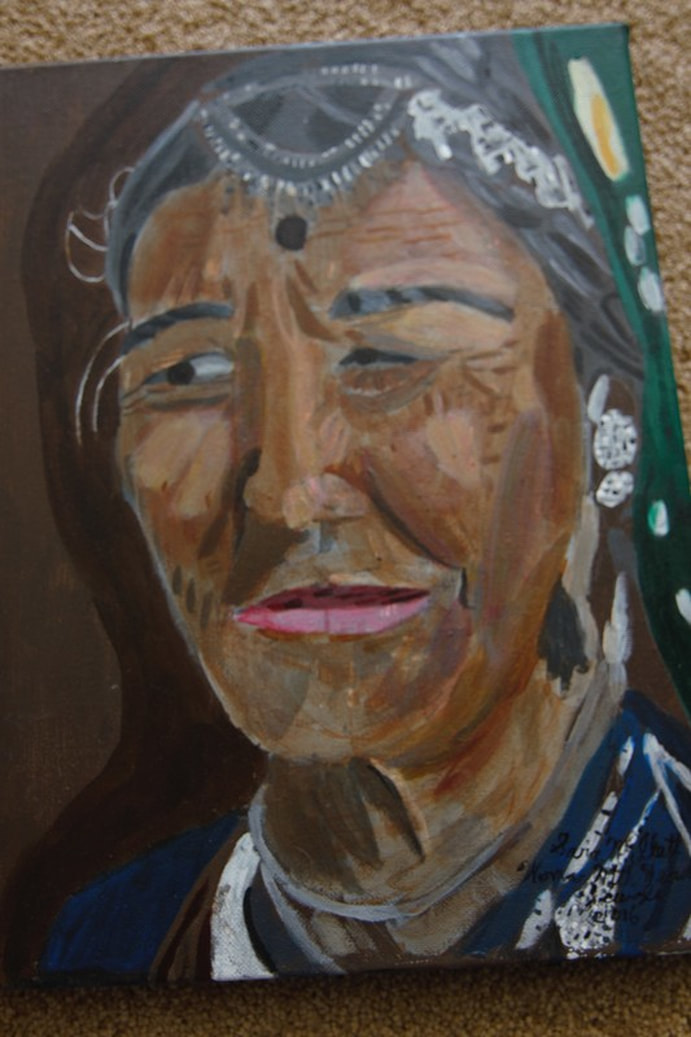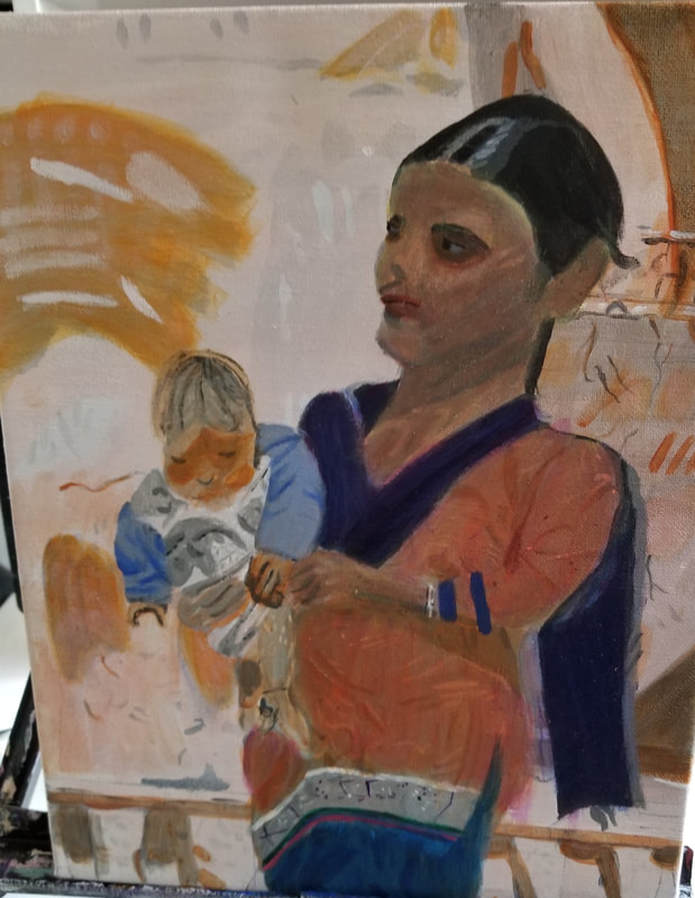|
In this video, I'm explaining that your subject's face will not all be the same color and the importance of looking at those parts which are darker or lighter than the rest. Neglecting these areas while portrait painting will result in you being very frustrated because your skin color just isn't coming out right.
0 Comments
In this video, I'm explaining the importance of focusing on facial structure before color when doing portraits. I came to this realization myself while working on my current painting titled ''You Looking At Me?", which you can see me working on in this video. This video features another appearance by my consciousness.
In the video included in this post, I'm explaining that, in addition to black, back hair is going to include shades of blue/brown/gray. I show footage of me working on a portrait of a man who has black hair and some photos of black hair to help demonstrate my points. Here's my standard hair painting tutorial. In this video, I'm encouraging you to motivate yourself to paint by looking at art. I'm giving you three places to see art in person. I got the idea to make this video after visiting the San Diego Art Museum in Balboa Park and feeling the pull to paint myself after seeing the art there.
When it comes to water mixable media, such as ink, it’s important to know how much water you add to control your values so I decided to work on discovering how to do this with India ink. I thought I would make a value scale where I would start with the ink pitch black, then slowly add more and more water having it get gradually lighter as I did, but things didn’t go quite according to plan. Watch the video below to find out what happened and what conclusion I came to. In this video, I'm talking about being honest with yourself as an artist. Listen to your consciousness when it tells you you need to remix a color or use a different brush. Doing so will help you be more productive as an artist.
In this post, we’re talking about techniques. Years ago I made a video claiming that I didn’t use any technique in my painting. Now I’d like to revise that. I think I really was using a technique or several and just didn’t, and still don’t, know what they were. I don’t think it’s possible to draw or paint without using any technique. I had the idea back then that artists who used techniques used one technique and that you had to pick a technique and stick with it or you couldn’t use technique at all. Now I know that artists can use as many techniques as they want. They can even combine techniques in the same painting. Sure there are artists who only ever use one technique, but that’s not a rule. I’m going to share with you the three techniques that I’m familiar with, regardless of whether or not I’ve actually used them. Glazing Glazing is the technique I’ve been experimenting with the most. To glaze you take paint colors that are already transparent, mix them with water or medium so they’re even more transparent, and apply them in multiple light layers. Glazing is commonly associated with realism because it allows artists to create very believable textures due to how light shows through the layers. Glazing as a painting technique has a long history. The Old Masters glazed. The texture of the woman’s skin in this painting and the woman’s tunic in this painting, was achieved through glazing. Wet Into Wet Wet into wet is done by putting color down on top of or next to another color without waiting for the first color to dry so that the colors blend together. You could think of it as mixing color right onto your canvas. The only time I personally use the wet into wet technique is when I think something is too dark or too light and I’m too lazy to remix a color, so I just layer some black or white onto my color that’s on the canvas while it’s still wet. Wet into wet is not easy to do in acrylics because they dry so fast, but you can do it if you have an airbrush that you can use to periodically mist your paint with water to keep it wet as you work. This video, from Lachri Fine Art, provides a demonstration of wet into wet blending. Impasto This is the one technique of the three that I have no personal experience with, but I find it very interesting. Impasto is applying paint very thickly to the canvas using bold strokes, sometimes with a palette knife. Impasto is commonly associated with impressionism, which is a style that revolves around lights and darks rather than fine detail. Van Gogh did an extreme version of impasto. A more recent artist associated with impasto was Lucian Freud. Unlike in glazing, the brush strokes in impasto are visible. Impasto is Italian for dough or mixture. In this video, I'm explaining that all your acrylic and oil painting surfaces need to be primed and demonstrating how to do that. I also answer the questions of why your painting surface needs a primer, how to tell if a canvas is already primed, why you should learn to gesso even though so many canvases come preprimed, and why can't use white paint as gesso.
In this post, I'm going to explain why I think it's okay to paint and draw from photographs. I made a post defending the concept of copying in general. This one is going to be a bit different from that one, though. Whereas in that post I was defending drawing from something artist's imagination, in this post I'm going to be defending working from photographs instead of or, better yet, in addition to, working from life. In no way am I saying you should only ever work from photos and forget about ever working from life. Absolutely not. I think being able to draw from life is a wonderful skill and I love getting an opportunity to practice it. This post is not criticizing drawing from life. What this post is criticizing is the insistence on drawing from life exclusively, or really, the insistence that other people draw from life exclusively. If you're reading this and you love drawing from life and you hate working from photos, you don't want to use them, I have no problem with that. I really wonder if the people who insist that artists work from life have even thought about how unrealistic that sounds. There are people that charge money to sit for artists who want to paint from life, because asking someone to remain motionless for a half an hour at a time so you can paint is a lot to ask of anyone. Yes, I can always look in the mirror and paint myself, but maybe I don't want to paint myself all the time. When it comes to animals, forget about it. I can barely manage to catch my dog being still for a few seconds, let alone a half hour. The above drawing was done from a photo I took when my dog just happened to stand still for a few seconds during a running around frenzy. The only time I could catch my dog being still long enough to maybe draw her from life is if she was sleeping and even then, she's probably wake up and start running around before I could finish. Some people think artists should always draw from life because that's how real artists did it, that's how the Old Masters did it. First of all, the Old Masters didn't even have cameras so working from life was pretty much their only option. Something the Old Masters did do, though, was if they were working on a large project, such as when Leonardo Da Vinci was working on "The Last Supper", they would go out onto the streets with their sketchbooks, sketch people that went by as quickly as possible as they went by, and then bring these sketches back to the studio to use as reference. If they'd had cameras would they have snapped photos of people to use? Who's to say? Sometimes it's not even about drawing a subject, for me at least. It's about capturing a scene, something that will only be there for a fleeting amount of time. Just go to my gallery and look at my wildlife section. Pretty much none of those pieces could have been done if I wasn't open to working from photos. Some words of caution, though, for artists who like to work from photos. Learn how to take a good reference photo and learn what makes a good reference photo.
Also, and this is very important, only work from photos that you take yourself or have permission to use, even if that permission is granted through a creative commons or royalty-free license, particularly if you want to be able to sell your piece. Copyright infringement can get you in a lot of trouble. Don't think that changing the photo gets you off the hook either. Even if you work from photos, the more yoh know about anatomy and perspective, the better off you'll be.
|
Sara MillettPainter of portraits and wildlife Archives
November 2023
Categories
All
|
||||||||


